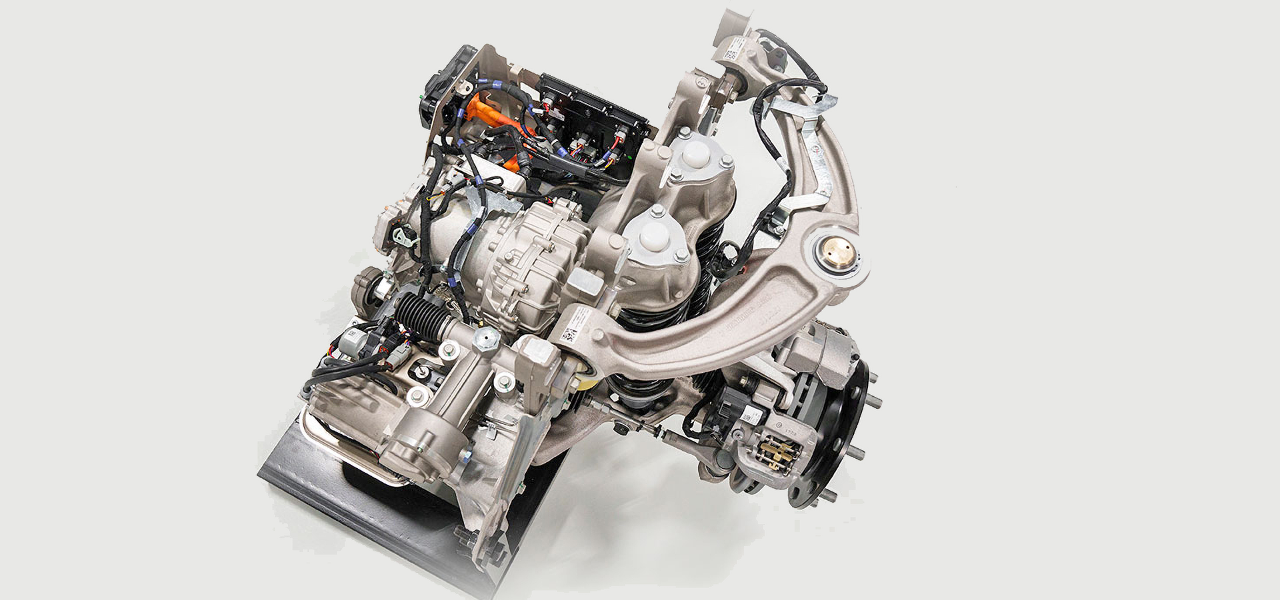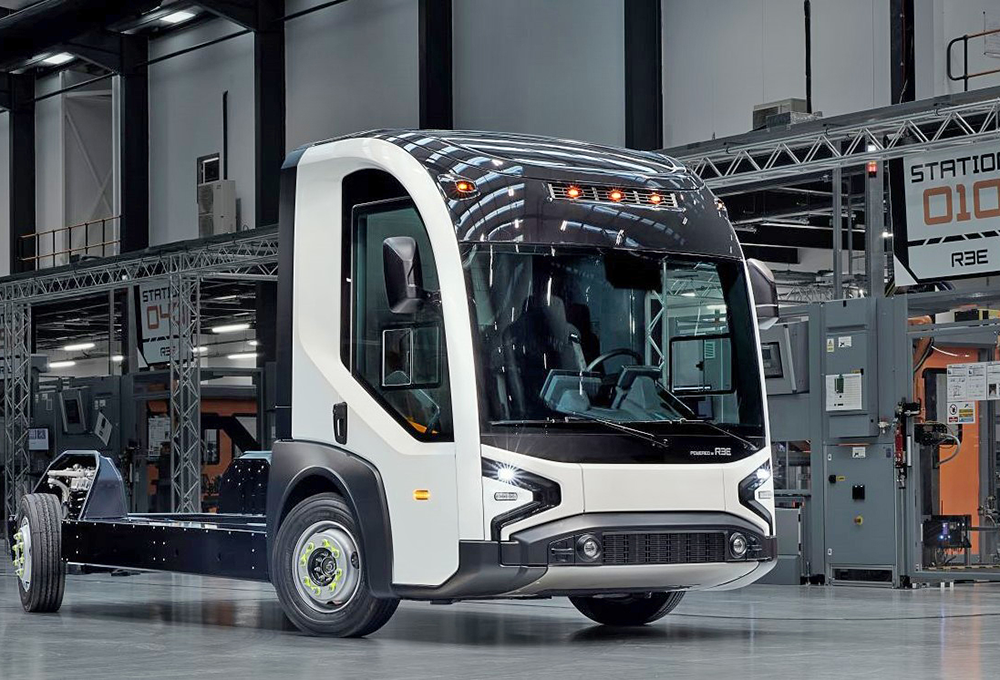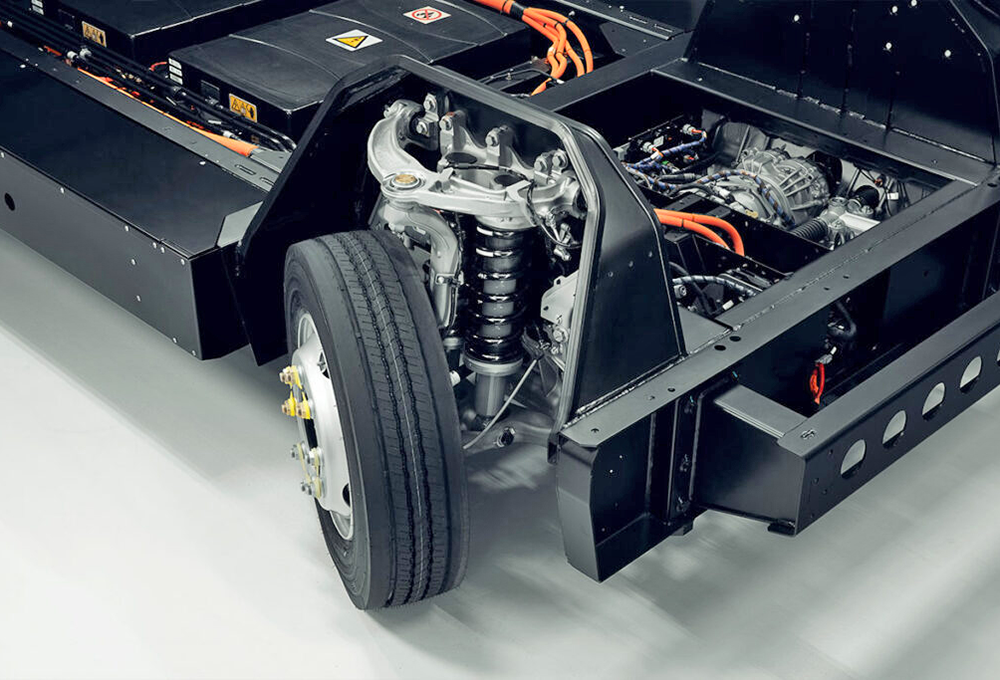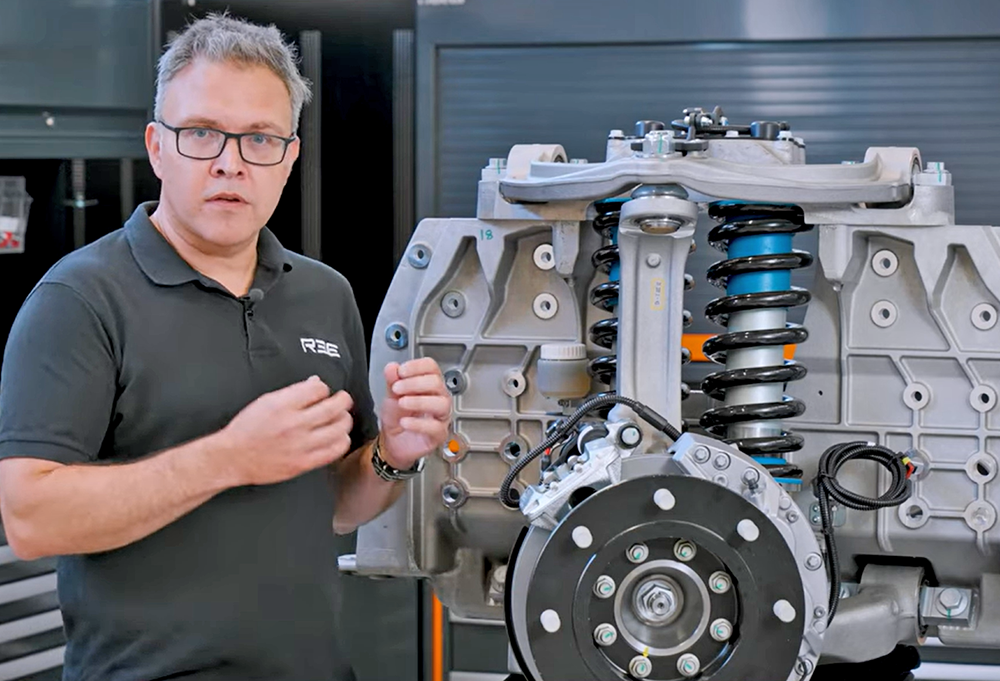 REE公司称,P7底盘的4个角模块具有相同的构造,降低了制造成本和复杂性。(REE)
REE公司称,P7底盘的4个角模块具有相同的构造,降低了制造成本和复杂性。(REE) REE P7底盘最初将提供两种配置:纯底盘和带驾舱底盘。(REE)
REE P7底盘最初将提供两种配置:纯底盘和带驾舱底盘。(REE) 通过在底盘和车轮之间的区域封装组件,REE 声称它能够设计出完全平整的P7底盘。(REE)
通过在底盘和车轮之间的区域封装组件,REE 声称它能够设计出完全平整的P7底盘。(REE) P7的制动系统采用 100% 线控制动,各种部件均由布雷博提供,包括其 Sensify 系统的一部分。(REE)
P7的制动系统采用 100% 线控制动,各种部件均由布雷博提供,包括其 Sensify 系统的一部分。(REE) Peter Dow,REE Automotive 工程副总裁。(REE)
Peter Dow,REE Automotive 工程副总裁。(REE)
REE Automotive的工程副总裁Peter Dow在接受SAE采访时表示:“REEcorners悬架系统是我们打造的这款卡车的核心技术,令我们能够实现理想的车辆动力学性能。我们不断尝试打造一款能够带来惊喜体验且易于驾驶的卡车。”
初版REE P7底盘将提供两种配置:纯底盘和带驾舱底盘。两种配置均可根据客户的具体要求和应用场景为3-5级中卡定制。据REE介绍,采用P7底盘制造的卡车具有业内最低的上车高度,可搭载自动驾驶平台,可使用蓄电池或燃料电池供电。
REEcorners模块由带横向转向连杆的铝制上下控制臂,以及带线性螺旋弹簧的固定阻尼率双油压减震器组成。每个角模块还集成了一个轮毂、驱动桥和一只四活塞布雷博(Brembo)卡钳。
P7底盘主要针对3-4级中卡设计,但也可应客户的要求集成到5级卡车中。Dow表示:“集成到5级卡车时,唯一的变化是弹簧部分。为降低悬架的动态高度,我们采用了双减震器。同时,为了使用螺旋弹簧,我们需要尽可能降低静态高度。”
Dow补充道:“实现上述功能的前提是每个角模块都有一个便于其在一小时内完成安装和更换的编号。我们采用了自动连接高压和低压系统的复式连接器,因此无需在角模块安装高压接线。我们正在尝试通过选择的组件尽可能使卡车底盘的外部接近传统设计。例如,我们选用的制动卡钳、转子和驻车制动系统均为布雷博的现有产品。”
他表示:“我们能够准确控制车辆运动,同时独立控制卡车四个角模块的驱动、制动和转向功能。之所以能做到这一点,是因为每个角模块都有负责管理转向、制动和牵引力的独立ECU。此外,我们还有一个可以管理所有角模块动作的中央控制单元。例如,当驾驶员发出偏航指令时,该系统可通过调整转向角、牵引力或扭矩矢量控制,响应其指令。”
Dow的团队还必须保证P7底盘的悬架可提供足够的空间来安装雪地防滑链等组件。Dow表示:“我们能够使P7的转向角达到32度。”
Dow表示:“我们一直在研究如何减少材料用量、提高产量,从而确定合理的价格。公司位于英国的制造中心的年产能可达到4万台。我们希望打造出适用于尽可能多车型的P7底盘。目前唯一需要调整的是弹簧刚度。”
REE已宣布,潘世奇卡车租赁公司(Penske Truck Leasing)即将开始向有意开展车队电气化改造的客户提供REE电动汽车,客户可以试驾,也可以订购。潘世奇采购与车队规划高级副总裁Paul Rosa 表示:“我们期待REE公司的线控汽车加入我们的电动卡车阵容,让我们的车队客户有机会试驾该车辆并亲身体验这项技术。”
REE Automotive is aiming to be a major disruptor in the medium-duty truck space with the rollout of its P7 EV chassis. The P7 frame is built around its “REEcorners” suspension, which are modular suspension units featuring REE’s x-by-wire design. By packaging components into the area between the chassis and the wheel, REE claims that it was able to design the P7 with a completely flat chassis with up to 35% more interior volume for passengers, cargo and batteries.
“The REEcorners suspension system is the core of the technology that we built this truck around,” Peter Dow, VP of engineering for REE Automotive, said during an interview with SAE Media. “It also allows us to achieve the level of vehicle dynamics we were looking for. We were trying to make a truck that was very exciting and easy to drive.”
The REE P7 Chassis will initially be offered in two configurations: a stripped chassis and cab/chassis. Both can be customized to customer specifications and use cases for Class 3-5. REE is claiming that vehicles built on the P7 Chassis have the industry’s lowest step-in height, are autonomous ready, and can be powered by either batteries or fuel cells.
Intelligent integration
The P7 is a radical departure from traditional medium-duty trucks in terms of suspension and chassis design. Compared to traditional ladder-frame, leaf spring designs, the P7 looks closer to an IMSA GTP machine under the skin than a delivery van.
The REEcorners are comprised of aluminum upper and lower control arms with a lateral link for steering and twin fixed-rate oil-charged dampers with linear-rate coil springs. Each corner also integrates a hub and drive axle with a four-piston Brembo caliper.
The corners integrate all critical functions including steering, braking suspension, powertrain and chassis control into a single module at each wheel. This means that all four wheels of the P7 are completely independent but can also be managed by a single ECU that controls all individual functions at each corner. All vehicle function controls are also electrified (i.e., drive-, steer- and brake-by-wire).
“All of the drive unit, steering and braking is managed at each individual corner,” Dow said. “We were looking into integrating a lot of control systems, such as torque vectoring and rear steer. We wanted a responsive suspension system to allow us to integrate those systems.”
The P7 was designed principally for Class 3 and 4 configurations but can also be outfitted for Class 5 duty should a customer desire. “The only thing we change for Class 5 is the springs,” Dow said. “We went with the twin damper setup because we wanted to reduce the travel height of the suspensions. In order to use coil springs, we needed to get the static height as low as possible.”
Cornering the market
All four corners of the P7’s suspension are identical, which according to REE reduces cost and complexity in manufacturing while also allowing for greater control over chassis behavior. “Certain things will change with the location of the corner,” Dow explained. “You will have a leading or trailing caliper for brakes depending on which side of the truck it is installed on, but our software compensates for that.”
Dow continued, “The whole premise is really about one part number for each corner that can be interchanged on and off the truck within a one-hour window. We have a multi-connector that connects the high- and low-voltage systems automatically, which means we have no high-voltage connections at the corners themselves. We’re trying to keep this outboard section of the truck as conventional as possible with the components we’re choosing. For example, the brake calipers, rotors and park brake system are all off-the-shelf pieces from Brembo.”
The P7’s brake system is 100% brake-by-wire, with various components supplied by Brembo including part of its Sensify system. “It has elements of the Sensify technology,” Dow said. “We have their system managing the pressure to disc and pad, and on top of that our application code assists to manage the ABS and other systems.”
The system uses a Brembo braking actuator with a 48V system that then drives up to 115 bar (1,668 psi) of pressure through the braking system. “Using this system means we get flexibility in terms of how we control the system. We can brake independently on all four corners,” Dow explained.
“We have a lot of control over the motion of the vehicle,” he said. “We have independent control over the drive, brake and steering of all four corners of the truck simultaneously. The way our control strategy works is each corner has its own ECU which manages the steering, braking and traction. We then have a central control unit that manages each corner in terms of action. For example, a driver will ask for a yaw command and that yaw may come from the steering angle or it may also come from the traction or torque vectoring.”
Safety (and stability) first
The P7 features a full suite of advanced safety systems such as active yaw control. REE has performed extensive testing to ensure the P7 will remain surefooted even in the worst conditions including testing at the Artic Circle in Sweden.
“On the low mu ice lakes with our active yaw system, we were able to eliminate any form of oversteer,” Dow said. “If you try and oversteer, we have the ability to use torque vectoring as well as the rear steer to keep the vehicle from spinning. Which means we have a very stable truck.”
Dow also explained the control strategy for the drive system. “We’re predominantly front-biased to start with in terms of drive,” he said. “We actually have a suspension travel sensor which allows us to understand what sort of load we have in the vehicle, which enables us to shift power to the rear as we gain load there.”
REE found during its testing that once load begins to reach the top of Class 4, it is helpful to vary the rear steering ratio to provide more stability during lane changes. “Rear steer will be active up to 20 mph (32 km/h) and then we blend it out as we reach that plateau. We also have the ability to select what we call anti-swipe,” Dow explained. “If you’re in a parking bay where you don’t want the rear steer to be active, we don’t engage the rear steering until you’ve traveled at least one vehicle length. Then the rear steering is brought online again to ensure that a driver does not tail swipe anything next to them.”
“Once we go to higher speeds, say 50-60 mph (80-96 km/h), we actually then bring the rear steering back in parallel for instances such as high-speed cornering and lane change maneuvers,” he added. “So we really use our algorithms and control strategies of the rear steer to provide maneuverability at low speed and stability at high speed.” Active rear toe is managed via rear steer. Active camber control could also be added. “Because we are truly independent across all four corners, there’s no linkage across corners like anti-roll bars,” Dow said. “We have a reasonably stiff suspension at each corner that we can work with. We are then looking at the control software to manage that roll motion of the vehicle depending on load.”
Dow’s team also had to ensure the P7’s suspension provided enough clearance to fit components such as snow chains. “We have enough ability to get up to 32 degrees of steering angle on this unit,” he said.
Dollars and sense
The beauty of REE’s approach to the P7’s suspension system is that it’s an existing technology that can easily be modified based on what corner the unit is being mounted on and what load the truck will be carrying.
“We were looking at how we can get volume to achieve a price point while using the least amount of materials,” Dow said. We have the capacity to make 40,000 of these units per year at our manufacturing center in the U.K. We wanted to have a configuration that was applicable to as many vehicle configurations as possible. The only thing we tune is the rate of the springs.”
All the metal structures, subframes, wishbones and knuckles are REE’s own designs that are being manufactured. The steering actuator is from twin-sourced external suppliers. “We’re trying to dual source as many options as possible in the system,” Dow explained. “The central drive unit is a 3-in-1 unit (motor/inverter/gearbox) that is cooled by a dielectric oil with a glycol interface that is also sourced from an external supplier.”
The main target market for the P7 is North America, but that’s not to say REE doesn’t have plans to bring the P7 elsewhere. “We’ve designed this to be a global product,” Dow said. “The chassis subsystem was designed principally for North America but with design protection for Europe as well as Japan. We’ve engineered crash and crumple zones in the front of the truck to look at European requirements even though we don’t need them for the U.S.”
REE has announced that Penske Truck Leasing will begin to offer Powered by REE EVs to its customers interested in electrifying their fleets for demos and orders. “We are looking forward to adding REE’s by-wire vehicle to our electric-truck lineup and giving our fleet customers the opportunity to demo the vehicle and experience the technology firsthand,” said Paul Rosa, senior VP of procurement and fleet planning at Penske.
等级
打分
- 2分
- 4分
- 6分
- 8分
- 10分
平均分
- 作者:MATT WOLFE
- 行业:商用车
- 主题:零部件动力与推进力质量、可靠性与耐久性运输系统车辆与性能车身/机身与架构车辆底盘与飞机起落架
